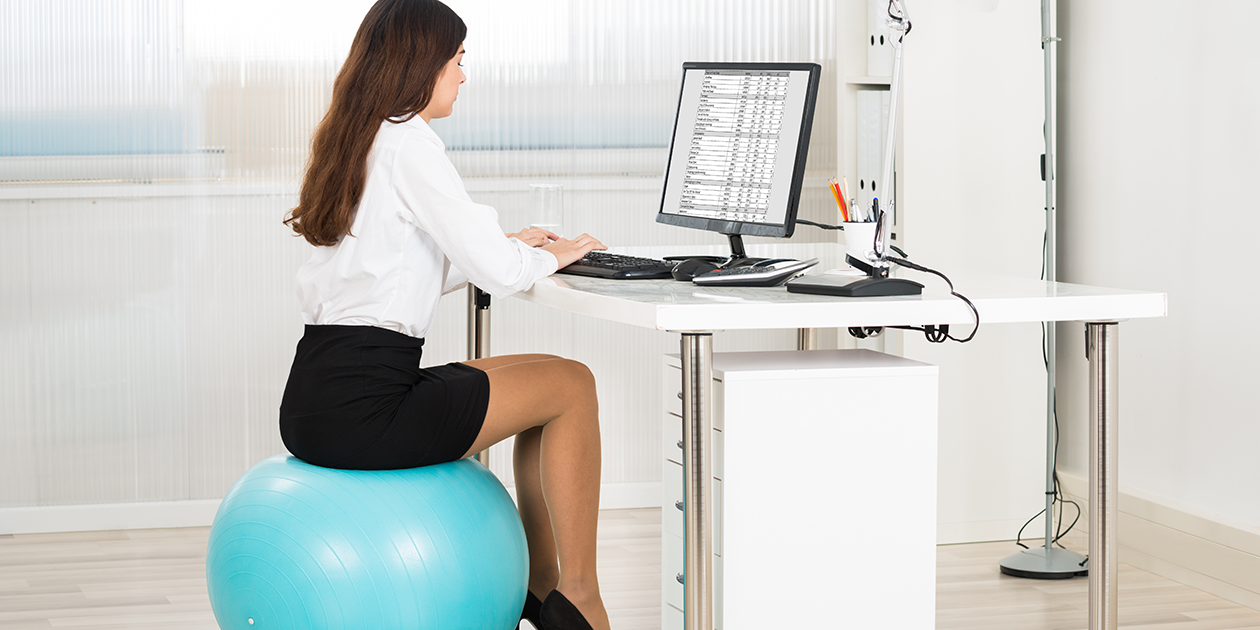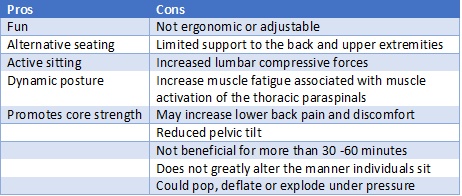
Have you noticed your coworkers sitting at their workstations on large round balls? I’m often asked what I think of using a ball at work. With recent attention to the active workplace, more and more people are seeking alternative postures to work. One such strategy some employees and employers are turning to is exercise balls in place of their ergonomic chairs.But is the stability ball really a good idea in the office?
Historically, the Swiss ball, developed in 1963, is an exercise ball used for fitness, rehab and conditioning primarily used by physical therapists for treatment of newborns and infants. Eventually, the ball was used to treat orthopedic and functional movement syndromes along with athletic training. In recent years, fitness experts, chiropractors and even some physicians have recommended sitting on an exercise ball instead of an office chair. This is based on the theory that the abdominal and back muscles are constantly engaged and active in order to sustain proper posture and balance on the ball.

Figure 2. Pros and cons of sitting on a ball at work.
This alternative seating is not without controversy. There are both pros and cons to using a Swiss Ball, balance or therapeutic stability ball in place of a supportive ergonomic chair. According to a Canadian study from the University of Waterloo (Gregory, 2006), there is limited scientific literature on the benefit occurring by sitting on the ball without additional exercises. From a negative perspective, the balls can be a safety hazard and liability by increasing the likelihood of falling off the ball or even popping or deflating underneath the weight of the user. Prolonged use can lead to significant postural fatigue and slouching resulting in increased discomfort and lumbar compression as reported by Gregory, et al in their 2006 study. Furthermore, Swiss balls as chairs are not ergonomic. Typically, there is no seat height adjustability, no lumbar support and no armrest support to allow for a better fit to the workstation or keyboard and mouse placement resulting in poor ergonomics. Even with a supportive wheeled base, these features are often lacking. Figure 2 provides some of the pros and cons of stability ball use in the office.
On the positive side, the Swiss ball does promote dynamic sitting and increased muscle activity resulting in increased core stability and strength. Mental stimulation and a sense of “fun” at work are also reported by ball users. And many companies welcome the alternative seating as part of the active workplace trend.
Employers who are trying to decide whether to allow employees to use balls to sit on in the office, be sure to evaluate the employee’s chair for fit and comfort. Most likely, therein lies the problem. Instead, invest in a supportive and adjustable ergonomic chair to last years to come.
At this point, there are limited small group studies and research on the Swiss ball as an alternative sitting option. There does not appear to be any advantage to using a stability ball as an office chair 2. Furthermore, there is no research on the impact of ball sitting on productivity or the physiological impact of continuous use of the exercise ball as an office workstation seat.
If you decide to sit on a stability ball at work, keep the following suggestions in mind:
- Build your tolerance for sitting on the ball.
- Don’t sit any more than 2-3x/day for 20-30 minutes, since it is dynamic sitting.
- Adjust your monitor, keyboard/mouse to fit when you’re on the ball.
- Make sure you don’t give up your ergonomic chair just yet!
- Adjust your ergonomic chair for a better fit and alternate between the two.
- Limit chair sitting in general to 60 minutes per session
- Add more standing and walking into your work routine (instead of ball/sitting).
For employers who allow stability balls, be sure to have a well-defined policy and procedures in place to support their use including requiring medical certification demonstrating need; and how, when and where they can be used. Keeping in mind the pros and cons, stability balls may be a good alternative for the active office when used correctly and on a limited basis.
What are your experiences with ball use at work? Have you sat on one yet? Let us know what you think!
References:
1. Exercise ball, https://en.wikipedia.org/wiki/Exercise_ball.
2. Gregory, D., Dunk, N., Callaghan, J., “Stability Ball versus Office Chair: Comparison of Muscle Activation and Lumbar Spine Posture during Prolonged Sitting”, HFES-Human Factors, April 2011.
3. Ergonomics in Design, Special Edition, HFES, Volume 23, Number 3, July 2015.
Thank you for reading WIN NEWS blog.

Comments (2)